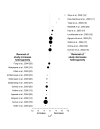A meta-analysis of N-acetylcysteine in contrast-induced nephrotoxicity: unsupervised clustering to resolve heterogeneity
- PMID: 18001477
- PMCID: PMC2200657
- DOI: 10.1186/1741-7015-5-32
A meta-analysis of N-acetylcysteine in contrast-induced nephrotoxicity: unsupervised clustering to resolve heterogeneity
Abstract
Background: Meta-analyses of N-acetylcysteine (NAC) for preventing contrast-induced nephrotoxicity (CIN) have led to disparate conclusions. Here we examine and attempt to resolve the heterogeneity evident among these trials.
Methods: Two reviewers independently extracted and graded the data. Limiting studies to randomized, controlled trials with adequate outcome data yielded 22 reports with 2746 patients.
Results: Significant heterogeneity was detected among these trials (I2 = 37%; p = 0.04). Meta-regression analysis failed to identify significant sources of heterogeneity. A modified L'Abbé plot that substituted groupwise changes in serum creatinine for nephrotoxicity rates, followed by model-based, unsupervised clustering resolved trials into two distinct, significantly different (p < 0.0001) and homogeneous populations (I2 = 0 and p > 0.5, for both). Cluster 1 studies (n = 18; 2445 patients) showed no benefit (relative risk (RR) = 0.87; 95% confidence interval (CI) 0.68-1.12, p = 0.28), while cluster 2 studies (n = 4; 301 patients) indicated that NAC was highly beneficial (RR = 0.15; 95% CI 0.07-0.33, p < 0.0001). Benefit in cluster 2 was unexpectedly associated with NAC-induced decreases in creatinine from baseline (p = 0.07). Cluster 2 studies were relatively early, small and of lower quality compared with cluster 1 studies (p = 0.01 for the three factors combined). Dialysis use across all studies (five control, eight treatment; p = 0.42) did not suggest that NAC is beneficial.
Conclusion: This meta-analysis does not support the efficacy of NAC to prevent CIN.
Figures







References
Publication types
MeSH terms
Substances
Grants and funding
LinkOut - more resources
Full Text Sources
Medical

